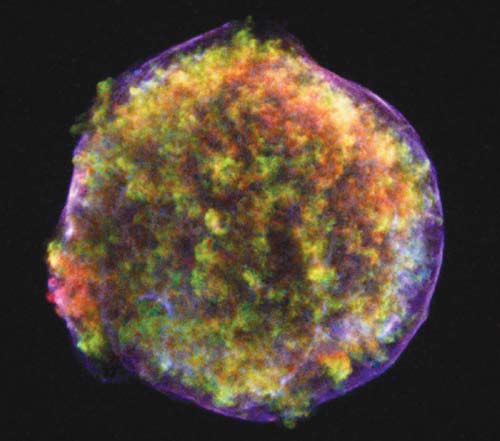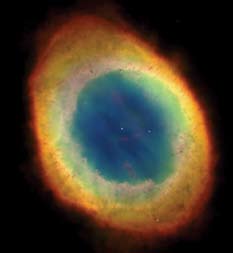 Left: Tycho’s supernova remnant (Chandra). NASA/CXC/Rutgers/J.Warren & J.Hughes et al.
Left: Tycho’s supernova remnant (Chandra). NASA/CXC/Rutgers/J.Warren & J.Hughes et al.
With stars, it would seem, size matters. It is the necessary but not absolute determinant of their ends:
(1) whether they expire in a thermonuclear explosion like the supernovae type Ia, or
(2) collapse and explode like the supernovae types Ib and II, or
(3) just quietly cool for eternity like the typical white dwarf.
Collapsing cores are the fate of stars eight times or more massive than the sun (the more massive the star, the faster its evolution). The residue of a supernova type II core collapse is either a neutron star or a black hole. Neutron stars are much smaller but much denser than white dwarfs.
The rest of the stars, including the Sun, burn up and degenerate into white dwarfs, which are about the size of the Earth. Late in their life cycle, these stars expand into what are called “red giants” (larger [hence “giants”] but cooler [hence “red”] as seen from Earth); and then the outer envelope puffs away leaving a little more than half the original mass. (See image below.)
So there are enormous numbers of white dwarfs in the universe, but the only ones we can observe are nearby in our own Milky Way Galaxy because these objects are dim. So all direct information about white dwarfs is based on observations of the way they look and behave in the present (since proximity of source to observer determines the age of light in the universe).
 Young white dwarf at the center of ejected matter. The Hubble Heritage Team
Young white dwarf at the center of ejected matter. The Hubble Heritage Team
One out of every 100 white dwarfs will supernova; the question for participants in the KITP 2007 degenerate star program and conference is why this particular white dwarf of the many? What determines the Ia supernova fate?
It would seem to be coupling — the orbiting of one star around another. Program organizer Rosanne Di Stefano focuses on two pairing possibilities: either two white dwarfs, or a white dwarf and a companion star. Still most pairs do not a supernova make, so the big question is what distinguishes the rare pair which do supernova? For a white dwarf to supernova, it has to gain matter somehow from somewhere, and the best, if not the only, way now under serious scientific consideration is from a companion star.
While traveling by ship from India to England to pursue graduate work, Subrahmanyan Chandrasekhar (awarded a Physics Nobel Prize in 1985 for his theoretical insights into the gravitational collapse of stars) worked out the quantum mechanical implications of the stellar endgame.
White dwarfs are small and dense. In the end-stages of their evolution, what holds up the star remnant (i.e., counteracts the contracting force of gravity) is degenerate electron pressure. Electrons, long-since stripped from atoms, cannot as fermions occupy the same state, so there is a limit to the extent to which electrons can, in effect, be squeezed together in space. Chandrasekhar worked out the largest mass that can be supported by electron degeneracy.
Theorists hypothesize that mass added to the white dwarf from a companion will overwhelm the degenerate electron pressure and trigger the Ia supernova explosion.
The process whereby the matter from one star (be it degenerate or not) is accreted by the other in such a way as to trigger the supernova chain reaction is, according to Di Stefano, “complex and not well understood.”
Craig Wheeler, the current president of the American Astronomical Society and a degenerate star program organizer, has been engrossed in the study of supernovae, especially the thermonuclear exploders, for three decades. “We have made a lot of progress in the past 30 years,” he said, “but some of the central issues such as ‘How do you get a white dwarf into the place where it can explode?’ have been a problem all along and are still a problem."
“What this conference is all about is the nature of the companion star,” said Wheeler referring to the greater gathering of supernova aficionados the week of March 19, in the midst of the four-month-long program. “All the chess pieces are on the board,” said Wheeler, “but we just don’t know how nature plays the game."
